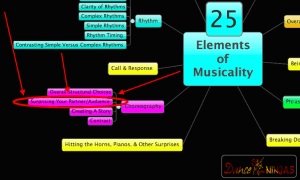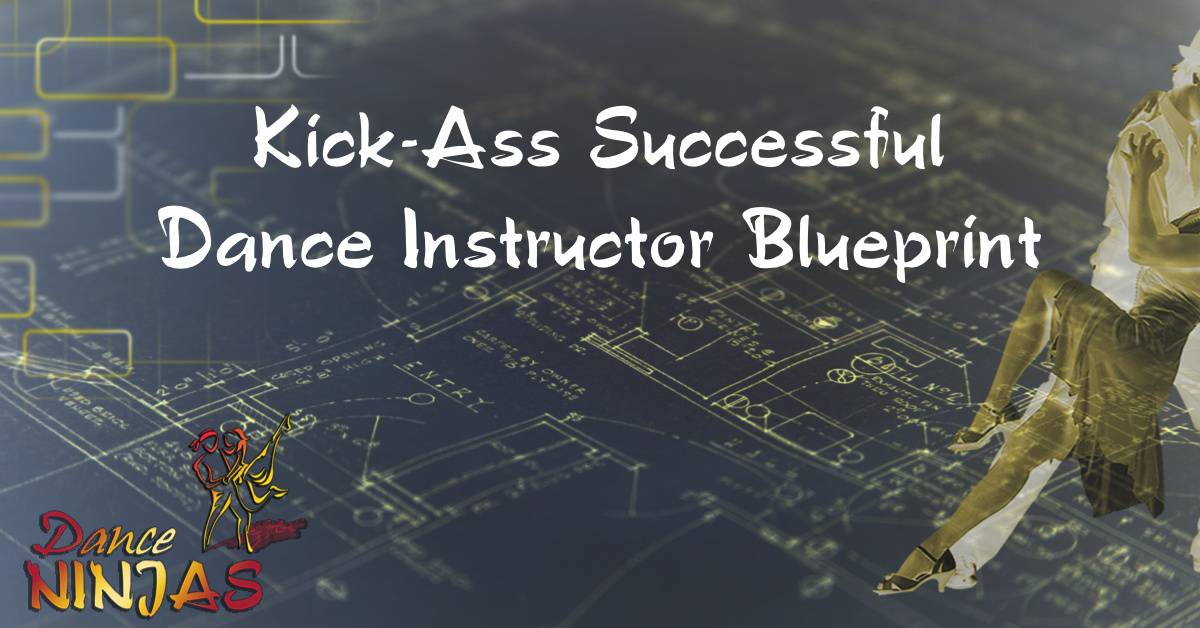When, Why, & How To Be Creative Without Going Overboard
How can you use surprises to create better dances?
When should you do them and how often?
Why are they valuable?
Well…
Surprising moves, or moves that are out of the ordinary (like dips, jumps, fancy leg tricks, etc), are a great way to get your partner (or audience) to feel you are creative and different.
For a beginner, it might be something as simple as a dip or a spin. For more advanced dancers, I’m sure you can think of some of your own movements that are more “out of the ordinary”.
If you do these moves too often, you’ll lose the element of surprise, and just be the one whose always dipping his partner, or doing a bunch of random stuff, or always does “that one move”.
And if you don’t do them often enough, you (or your partner/audience) might feel like your dances are boring.
So how often is the right amount?
Well, it depends on the song and several other elements (see step 9 below).
Many songs have at least one, and often a few, drastic changes in the feel of the song, so if you time those surprise moments to hit when the music makes more drastic changes, your surprises will feel more musical and purposeful then if you just randomly use them.
Here is a 9 step method to improve your ability to choose the right moments and implement your surprises.
NOTE: While all the steps below can be performed while actually dancing, for your first time doing these drills we recommend doing steps 1-7 on your own, not dancing, but just listening to the music.
Steps 8 & 9 will have you apply the concepts to your dancing, which can be very easy if you hear when the surprise moments are happening. But if you try to do steps 1-7 while dancing on your first run through, you will probably miss out on improving in this skill because you will be distracted by various other elements of dance.
Step 1: Choose the Single Biggest Change
Listen to a song all the way through and pick out the single most obvious change in the music.
It can be a change in the feel, a more drastic hit or break, something in the lyrics, or any other musical element that stands out to you as the most drastic difference in the song.
If you are going to do something special or different, this is probably the best moment to do it.
Does that make sense?
Try it out with this song by the amazing and revolutionary artist, David Keogh:
Share the time when you think the song has it’s most drastic change in the comments below.
Compare yours to the times others have mentioned, and then come back to this spot and keep reading.
Ok, are you ready for the next step?
Step 2: Choose the Next Biggest Changes
Now listen to the same song again.
Are there any other changes that are similar in their degree of change compared to the most obvious change in that song? If so, how many?
Those are also great moments to throw in surprises.
Step 3: Repeat with New Songs
Repeat steps 1 & 2 at least two more times with different songs before moving on and if you struggle with step 4, come back and do this more.
This will give you a feel for how different those moments usually are and how often they tend to happen in the styles of music you enjoy dancing to.
The more you do this step, the easier the rest of this will become!
Here are some more great songs by David Keogh to try this out with:
Step 4: Choose…As They Happen
Now we are taking it to the next level…
Listen to the first 60 seconds of a song you’ve never heard before. This is your prep time before you test yourself.
As you continue to listen to the remainder of the song, try to call out the moments that you think are the most obvious changes…
…here’s the important part…
…call them out as they happen!
So as soon as you hear a big change that you think is either the biggest or one of the biggest changes the song will have, write down the time of that change and whether you think it will be THE biggest change or ONE OF the biggest changes.
At the end of the song, evaluate your choices.
Did you pick the actual most drastic change as your most drastic change?
If not, did you at least pick it as one of the most drastic changes?
Note: You can ignore any drastic changes that happen in the first 60 seconds when evaluating yourself, since that is your “prep time”.
Do step 4 at least two more times before moving on as this will train you to be able to pick out the most drastic changes on the fly.
Step 5: Move Ahead or Go Back
Choose the option that suits your situation:
A. If you are having trouble picking the most drastic changes in the songs in step 4, go back and repeat steps 1-3 a few more times.
B. If you picked correctly (or mostly correct), move on to step 6.
Often, it doesn’t make sense to move on, if you are still struggling with the previous steps.
That said, sometimes pushing yourself to the extremes and then stepping back can help too.
So if you didn’t do so well but you want to move on to step 6 and really push yourself, that is ok too! It might even make this step seem a little easier when you come back to it.
Step 6: Shorten Your Prep Time
Listen to the first 30 seconds of another song you’ve never heard before (or 15 seconds or 0 seconds).
Shortening your prep time will make it harder to predict the biggest changes, but it will also push you to improve in this skill.
As you continue to listen to the song try to call out THE biggest change and the next biggest changes, writing down the time of each prediction as it happens.
At the end of the song, evaluate your picks again.
Did you pick the actual most drastic change as your most drastic change?
If not, did you at least pick it as one of the most drastic changes?
Remember: You can ignore any drastic changes that happen in the first 30 (or 15) seconds when evaluating yourself, since that is your “prep time”.
Repeat this step at least 2 more times before moving on.
Step 7: Evaluate Your Predictions Again
A: If you struggled in step 6, go back to step 4.
B: If you picked correctly (or mostly correct) in step 6, then repeat it again while shortening the prep time even further.
Eventually you want to get to the point where you don’t need any prep time.
However, even if you never achieve this, just by striving for it, your prep time will continue to decrease, and that is awesome!
Step 8: Apply Your Surprises While Partner Dancing
There are two ways to do this.
Yes, you can actually choose some movements (dips, tricks, etc) before the dance even starts and then wait for those big changes in the music to add them in.
This is easier for dancers that are not used to letting the music choose their movements yet and is a good starting point.
That said, try to work towards option B.
B. Let the music choose the surprise for you
As you dance, the musical elements in the song can sort of pull movements from your body.
This happens a lot when you choose “never to move unless the music moves you” (which is a great training method on it’s own).
Dancing like this tends to look more authentic and surprising.
However, this method also tends to create movements that are less well rehearsed and therefore, can be less clean and clear.
Use which ever method works best for you right now, as the point of this lesson plan is NOT to work on which method you choose for implementing the surprise, but instead to improve your ability to choose the best moments to implement those surprises.
Step 9: Be Willing To Bail On Your Surprise!
The purpose of using a surprise is to increase the enjoyment of the dance…
…so if you realize that you are going bump into someone, or the move feels dangerous or out of control, or the music doesn’t hit like you thought it was going to, or the move doesn’t fit the venue’s vibe at the moment, etc…
…don’t be afraid to skip the surprise and save it for another time.
Remember, a great dancer doesn’t just do awesome stuff but they also know when to do that awesome stuff!
Follow these steps and you are sure to become more creative and more musical!
If you like this post… you’ll love our Dance Trainings… check them out below.
Dancers…Want step by step drills to improve in many musicality topics like the one above as well as connection concepts and more? Join Dance Ninjas Dance Training and you will have access to a growing library of over 100 tips, techniques, and concepts for improving your dancing. And if what you want to learn isn’t available, just ask for it and we will create it. Teachers…Want step by step drills to teach your students to improve in their musicality and connection? Join Teachers Learning Teacher Training and you will have access to a growing library of over 100 tips, techniques, and concepts for teaching dance. And if what you want to learn isn’t available, just ask for it and we will create it. |
Got anything to add to this topic? Reply in the comments below.



What is your
The transition at 3:31 is the biggest transition for me.
After that, I’d say 1:54 and 2:49 are also big transition moments for me. One thing to note though, is that the transition at 2:49 continues until 3:30, so if I choose that section for a surprise I’d want to keep it (or something similar) going for the duration of the 41 seconds, where as the other two transition sections are much shorter.